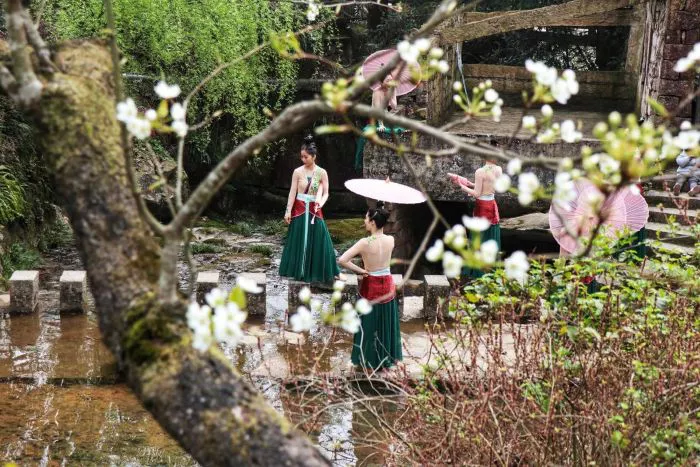FUSHAN TOWNSHIP, Zhejiang — The semi-mountainous village of Banshan came alive with vibrant cultural activities on March 18 as locals celebrated the Huazhao Festival (Flower Goddess Festival), drawing crowds of visitors eager to capture the spring blossoms through their lenses.
Dating back to the Spring and Autumn period (770-476 BCE) with records in ancient texts like “Tao Zhu Gong’s Book,” this traditional festival honors floral deities through time-honored customs. Historically observed on the second, twelfth, or fifteenth day of the second lunar month, celebrations feature flower-adornment rituals called “shanghong” and countryside excursions known as “taqing.”
Twelve performers dressed as floral deities in flowing Hanfu robes moved gracefully to classical music, recreating scenes from traditional Chinese paintings. The festival grounds buzzed with Sichuan opera face-changing performances, riverside concerts, and Hanfu processions that contrasted beautifully with the village’s blooming pear blossoms.
“I’ve been livestreaming our gorgeous pear blossoms to attract visitors,” said a local influencer, noting enthusiastic responses from Shanghai-based followers. “Seeing our flowers gain popularity fills me with hometown pride.”
The cultural revival brought tangible economic benefits, with villagers selling out local specialties like earth eggs (2 yuan each) and wheat pancakes (10 yuan each) at pop-up market stalls. Authorities report successful integration of cultural heritage with rural tourism, converting traditional assets into economic gains.
This year’s carefully curated events provided visitors with immersive experiences of the festival’s ceremonial traditions while showcasing the region’s natural beauty and cultural legacy.
Related Topic:
- Is Your ID Ready for the REAL ID Deadline on May 7?
- Does HBO’s “100 Foot Wave” dive into the world of big wave surfing?
- Is Indonesia’s Travel Advisory Warning Travelers Away from Certain Regions?

